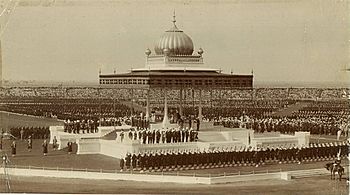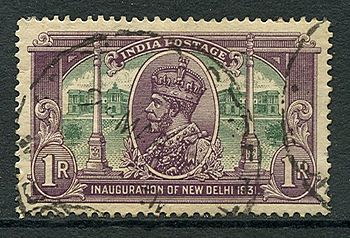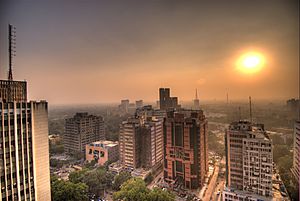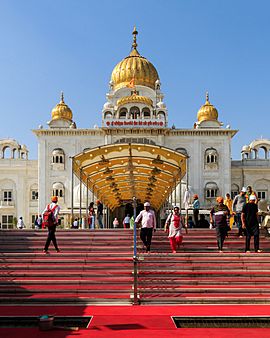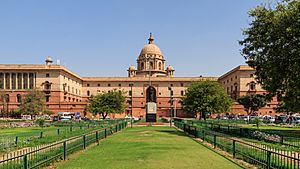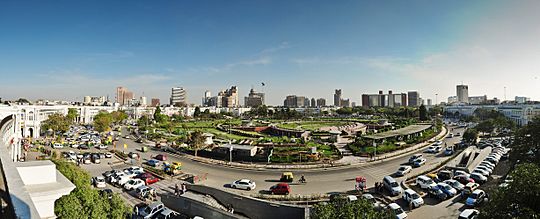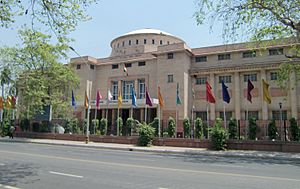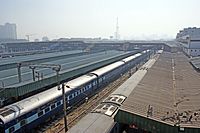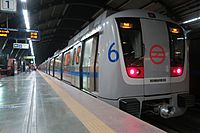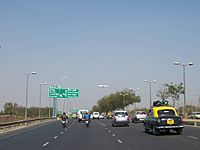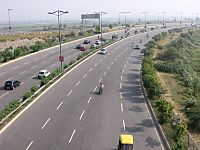New Delhi facts for kids
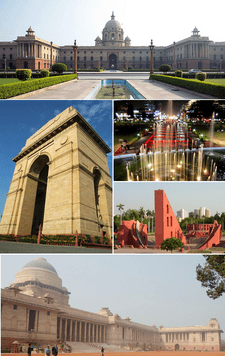
New Delhi (Hindi: नई दिल्ली) is the capital city of the modern Republic of India. It has a very old history.
The foundation stone of the city was laid by Emperor George V during the Delhi Durbar of 1911. It was designed by British architects, Sir Edwin Lutyens and Sir Herbert Baker. The new capital was inaugurated on 13 February 1931, by Viceroy and Governor-General of India Lord Irwin.
In traditional Indian geography it falls under the North Indian zone.
The city has an area of about 42.7 km2.
New Delhi has a population of about 9.4 mio. people.
Contents
History
Establishment
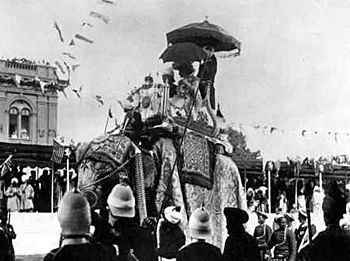
Calcutta (now Kolkata) was the capital of India during the British Raj, until December 1911. Calcutta had become the centre of the nationalist movements since the late nineteenth century, which led to the Partition of Bengal by then Viceroy of British India, Lord Curzon. This created massive political and religious upsurge including political assassinations of British officials in Calcutta. The anti-colonial sentiments amongst the public led to complete boycott of British goods, which forced the colonial government to reunite Bengal and immediately shift the capital to New Delhi.
Old Delhi had served as the political and financial centre of several empires of ancient India and the Delhi Sultanate, most notably of the Mughal Empire from 1649 to 1857. During the early 1900s, a proposal was made to the British administration to shift the capital of the British Indian Empire, as India was officially named, from Calcutta on the east coast, to Delhi. The Government of British India felt that it would be logistically easier to administer India from Delhi, which is in the centre of northern India. The land for building the new city of Delhi was acquired under the Land Acquisition Act 1894.
During the Delhi Durbar on 12 December 1911, George V, then Emperor of India, along with Queen Mary, his consort, made the announcement that the capital of the Raj was to be shifted from Calcutta to Delhi, while laying the foundation stone for the Viceroy's residence in the Coronation Park, Kingsway Camp. The foundation stone of New Delhi was laid by King George V and Queen Mary at the site of Delhi Durbar of 1911 at Kingsway Camp on 15 December 1911, during their imperial visit.
Large parts of New Delhi were planned by Edwin Lutyens, who first visited Delhi in 1912, and Herbert Baker, both leading 20th-century British architects. The contract was given to Sobha Singh. The original plan called for its construction in Tughlaqabad, inside the Tughlaqabad fort, but this was given up because of the Delhi-Calcutta trunk line that passed through the fort. Construction really began after World War I and was completed by 1931. The city that was later dubbed "Lutyens' Delhi" was inaugurated in ceremonies beginning on 10 February 1931 by Lord Irwin, the Viceroy. Lutyens designed the central administrative area of the city as a testament to Britain's imperial aspirations.
Soon Lutyens started considering other places. Indeed, the Delhi Town Planning Committee, set up to plan the new imperial capital, with George Swinton as chairman, and John A. Brodie and Lutyens as members, submitted reports for both North and South sites. The central axis of New Delhi, which today faces east at India Gate, was previously meant to be a north-south axis linking the Viceroy's House at one end with Paharganj at the other. Eventually, owing to space constraints and the presence of a large number of heritage sites in the North side, the committee settled on the South site. A site atop the Raisina Hill, formerly Raisina Village, a Meo village, was chosen for the Rashtrapati Bhawan, then known as the Viceroy's House. Subsequently, the foundation stone was shifted from the site of Delhi Durbar of 1911–1912, where the Coronation Pillar stood, and embedded in the walls of the forecourt of the Secretariat.
The Rajpath, also known as King's Way, stretched from the India Gate to the Rashtrapati Bhawan. The Secretariat building, the two blocks of which flank the Rashtrapati Bhawan and houses ministries of the Government of India, and the Parliament House, both designed by Baker, are located at the Sansad Marg and run parallel to the Rajpath.
After the capital of India moved to Delhi, a temporary secretariat building was constructed in a few months in 1912 in North Delhi. Most of the government offices of the new capital moved here from the 'Old secretariat' in Old Delhi (the building now houses the Delhi Legislative Assembly), a decade before the new capital was inaugurated in 1931. Many employees were brought into the new capital from distant parts of India, including the Bengal Presidency and Madras Presidency. Subsequently, housing for them was developed around Gole Market area in the 1920s. Built in the 1940s, to house government employees, with bungalows for senior officials in the nearby Lodhi Estate area, Lodhi colony near historic Lodhi Gardens, was the last residential areas built by the British Raj.
Post-independence
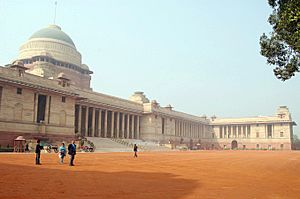
After India gained independence in 1947, a limited autonomy was conferred to New Delhi and was administered by a Chief Commissioner appointed by the Government of India. In 1966, Delhi was converted into a union territory and eventually the Chief Commissioner was replaced by a Lieutenant Governor. The Constitution (Sixty-ninth Amendment) Act, 1991 declared the Union Territory of Delhi to be formally known as National Capital Territory of Delhi. A system was introduced under which the elected Government was given wide powers, excluding law and order which remained with the Central Government. The actual enforcement of the legislation came in 1993.
Geography
With a total area of 42.7 km2 (16.5 sq mi), New Delhi forms a small part of the Delhi metropolitan area. Since the city is located on the Indo-Gangetic Plain, there is little difference in elevation across the city. New Delhi and surrounding areas were once a part of the Aravali Range; all that is left of those mountains is the Delhi Ridge, which is also called the Lungs of Delhi. While New Delhi lies on the floodplains of the Yamuna River, it is essentially a landlocked city. East of the river is the urban area of Shahdara. New Delhi falls under the seismic zone-IV, making it vulnerable to earthquakes.
Seismology
New Delhi lies on several fault lines and thus experiences frequent earthquakes, most of them of mild intensity.
Climate
The climate of New Delhi is a monsoon-influenced humid subtropical climate (Köppen Cwa) bordering a hot semi-arid climate with high variation between summer and winter in terms of both temperature and rainfall. The temperature varies from 46 °C (115 °F) in summers to around 0 °C (32 °F) in winters.
Air quality
In Mercer's 2015 annual quality-of-living survey, New Delhi ranks at number 154 out of 230 cities due to bad air quality and pollution. The World Health Organization ranked New Delhi as the world's worst polluted city in 2014 among about 1,600 cities the organisation tracked around the world. In 2016, United States Environmental Protection Agency listed New Delhi as the most polluted city on Earth.
In an attempt to lessen air pollution in New Delhi, which gets worse during the winter, a temporary alternate-day travel scheme for cars using the odd- and even-numbered license plates system was announced by Delhi government in December 2015. In addition, trucks were to be allowed to enter India's capital only after 11 pm, two hours later than the existing restriction. The driving restriction scheme was planned to be implemented as a trial from 1 January 2016 for an initial period of 15 days. The restriction was in force between 8 am and 8 pm, and traffic was not restricted on Sundays. Public transportation service was increased during the restriction period.
On 16 December 2015, the Supreme Court of India mandated several restrictions on Delhi's transportation system to curb pollution. Among the measures, the court ordered to stop registrations of diesel cars and sport utility vehicles with an engine capacity of 2,000 cc and over until 31 March 2016. The court also ordered all taxis in the Delhi region to switch to compressed natural gas by 1 March 2016. Transportation vehicles that are more than 10 years old were banned from entering the capital.
Demographics
New Delhi has a population of 257,803. Hindi is the most widely spoken language in New Delhi and the lingua franca of the city. English is primarily used as the formal language by business and government institutes. New Delhi has a literacy rate of 89.38% according to 2011 census, which is highest in Delhi.
Religion
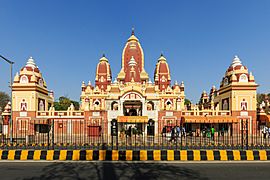

Except for Hinduism, the proportions of other religions are different and relatively lower in New Delhi as compared to entire NCT. According to 2011 census, Hinduism is the religion of 89.8%), Christians (2.9%), Sikhs (2.0%), Jains (0.4%). Other religious groups include Parsis, Buddhists and Jews.
Government
The national capital of India, New Delhi is jointly administered by both the Central Government of India and the local Government of Delhi, it is also the capital of the National Capital Territory (NCT) of Delhi.
As of 2015[update], the government structure of the New Delhi Municipal Council includes a chairperson, three members of New Delhi's Legislative Assembly, two members nominated by the Chief Minister of the NCT of Delhi and five members nominated by the central government.
The head of state of Delhi is the Lieutenant Governor of the Union Territory of Delhi, appointed by the President of India on the advice of the Central government and the post is largely ceremonial, as the Chief Minister of the Union Territory of Delhi is the head of government and is vested with most of the executive powers. According to the Indian constitution, if a law passed by Delhi's legislative assembly is repugnant to any law passed by the Parliament of India, then the law enacted by the parliament will prevail over the law enacted by the assembly.
New Delhi is governed through a municipal government, known as the New Delhi Municipal Council (NDMC). Other urban areas of the metropolis of Delhi are administered by the Municipal Corporation of Delhi (MCD). However, the entire metropolis of Delhi is commonly known as New Delhi in contrast to Old Delhi.
Economy
New Delhi is the largest commercial city in northern India.
Connaught Place, one of North India's largest commercial and financial centres, is located in the northern part of New Delhi. The city's service sector has expanded due in part to the large skilled English-speaking workforce that has attracted many multinational companies. Key service industries include information technology, telecommunications, hotels, banking, media and tourism.
Culture
New Delhi is a cosmopolitan city due to the multi-ethnic and multi-cultural presence of the vast Indian bureaucracy and political system. The city's capital status has amplified the importance of national events and holidays. National events such as Republic Day, Independence Day and Gandhi Jayanti (Gandhi's birthday) are celebrated with great enthusiasm in New Delhi and the rest of India. On India's Independence Day (15 August) the Prime Minister of India addresses the nation from the Red Fort. Most Delhiites celebrate the day by flying kites, which are considered a symbol of freedom. The Republic Day Parade is a large cultural and military parade showcasing India's cultural diversity and military might.
Religious festivals include Diwali (the festival of light), Maha Shivaratri, Teej, Durga Puja, Mahavir Jayanti, Guru Nanak Jayanti, Holi, Lohri, Eid ul-Fitr, Eid ul-Adha, Raksha Bandhan, and Christmas. The Qutub Festival is a cultural event during which performances of musicians and dancers from all over India are showcased at night, with the Qutub Minar as the chosen backdrop of the event. Other events such as Kite Flying Festival, International Mango Festival and Vasant Panchami (the Spring Festival) are held every year in Delhi.
Historic sites, museums and gardens
New Delhi is home to several historic sites and museums. The National Museum which began with an exhibition of Indian art and artefacts at the Royal Academy in London in the winter of 1947–48 was later at the end was shown at the Rashtrapati Bhawan in 1949. Later it was to form a permanent National Museum. On 15 August 1949, the National Museum was formally inaugurated and currently has 200,000 works of art, both of Indian and foreign origin, covering over 5,000 years.
The India Gate built in 1931 was inspired by the Arc de Triomphe in Paris. It is the national monument of India commemorating the 90,000 soldiers of the Indian Army who lost their lives while fighting for the British Raj in World War I and the Third Anglo-Afghan War. The monument is barricaded now with entry to inside arch restricted.
The Rajpath which was built similar to the Champs-Élysées in Paris is the ceremonial boulevard for the Republic of India located in New Delhi. The annual Republic Day parade takes place here on 26 January. The Beating retreat takes place here 2 days later.
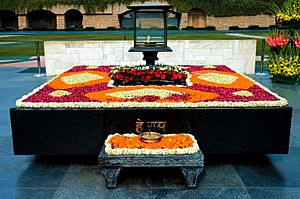
Gandhi Smriti in New Delhi is the location where Mahatma Gandhi spent the last 144 days of his life and was assassinated on 30 January 1948. Rajghat is the place where Mahatma Gandhi was cremated on 31 January 1948 after his assassination and his ashes were buried and make it a final resting place beside the sanctity of the Yamuna River. The Raj Ghat in the shape of large square platform with black marble was designed by architect Vanu Bhuta.
Jantar Mantar located in Connaught Place was built by Maharaja Jai Singh II of Jaipur. It consists of 13 architectural astronomy instruments. The primary purpose of the observatory was to compile astronomical tables, and to predict the times and movements of the sun, moon and planets.
New Delhi is home to Indira Gandhi Memorial Museum, National Gallery of Modern Art, National Museum of Natural History, National Rail Museum, National Handicrafts and Handlooms Museum, National Philatelic Museum, Nehru Planetarium, Shankar's International Dolls Museum. and Supreme Court of India Museum.
New Delhi is particularly renowned for its beautifully landscaped gardens that can look quite stunning in spring. The largest of these include Buddha Jayanti Park and the historic Lodi Gardens. In addition, there are the gardens in the Presidential Estate, the gardens along the Rajpath and India Gate, the gardens along Shanti Path, the Rose Garden, Nehru Park and the Railway Garden in Chanakya Puri. Also of note is the garden adjacent to the Jangpura Metro Station near the Defence Colony Flyover, as are the roundabout and neighbourhood gardens throughout the city.
Transport
Air
Indira Gandhi International Airport, situated to the southwest of Delhi, is the main gateway for the city's domestic and international civilian air traffic. In 2012–13, the airport was used by more than 35 million passengers, making it one of the busiest airports in South Asia.
In 2010, Indira Gandhi International Airport (IGIA) was conferred the fourth best airport award in the world in the 15–25 million category, and Best Improved Airport in the Asia-Pacific Region by Airports Council International.
Road
New Delhi has one of India's largest bus transport systems. Buses are operated by the state-owned Delhi Transport Corporation (DTC), which owns largest fleet of compressed natural gas (CNG)-fueled buses in the world. Personal vehicles especially cars also form a major chunk of vehicles plying on New Delhi roads. New Delhi has the highest number of registered cars compared to any other metropolitan city in India. Taxis and Auto Rickshaws also ply on New Delhi roads in large numbers. New Delhi has one of the highest road density in India and average vehicle speed is around 15-20 kmph in peak hours in the city.
Railway
New Delhi is a major junction in the Indian railway network and is the headquarters of the Northern Railway. The five main railway stations are New Delhi railway station, Old Delhi, Nizamuddin Railway Station, Anand Vihar Railway Terminal and Sarai Rohilla. The Delhi Metro, a mass rapid transit system built and operated by Delhi Metro Rail Corporation (DMRC), serves many parts of Delhi and the neighbouring cities Faridabad, Gurgaon, Noida and Ghaziabad.
Metro
The Delhi Metro is a rapid transit system serving New Delhi, Delhi, Gurgaon, Faridabad, Noida, and Ghaziabad in the National Capital Region of India. Delhi Metro is the world's 12th largest metro system in terms of length. Delhi Metro was India's first modern public transportation system, which had revolutionised travel by providing a fast, reliable, safe, and comfortable means of transport.
Cityscape
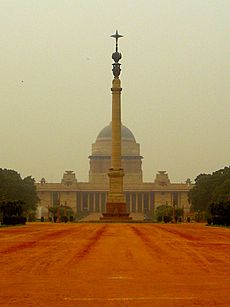
Much of New Delhi, planned by the leading 20th-century British architect Edwin Lutyens, was laid out to be the central administrative area of the city as a testament to Britain's imperial ambitions. New Delhi is structured around two central promenades called the Rajpath and the Janpath. The Rajpath, or King's Way, stretches from the Rashtrapati Bhavan to the India Gate. The Janpath (Hindi: "Path of the People"), formerly Queen's Way, begins at Connaught Circus and cuts the Rajpath at right angles. 19 foreign embassies are located on the nearby Shantipath (Hindi: "Path of Peace"), making it the largest diplomatic enclave in India.
At the heart of the city is the magnificent Rashtrapati Bhavan (formerly known as Viceroy's House) which sits atop Raisina Hill. The Secretariat, which houses ministries of the Government of India, flanks out of the Rashtrapati Bhavan. The Parliament House, designed by Herbert Baker, is located at the Sansad Marg, which runs parallel to the Rajpath. Connaught Place is a large, circular commercial area in New Delhi, modelled after the Royal Crescent in England. Twelve separate roads lead out of the outer ring of Connaught Place, one of them being the Janpath.
Images for kids
-
The 2010 Commonwealth Games opening ceremony at the Jawaharlal Nehru Stadium. In the foreground, there is an aerostat.
See also
 In Spanish: Nueva Delhi para niños
In Spanish: Nueva Delhi para niños


